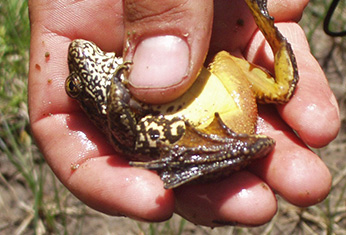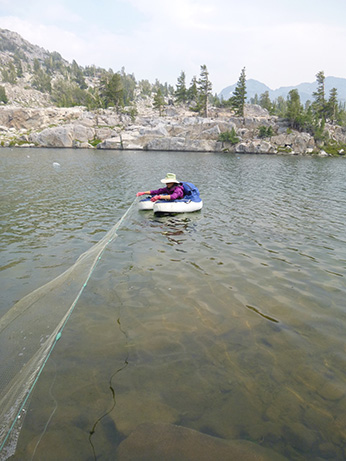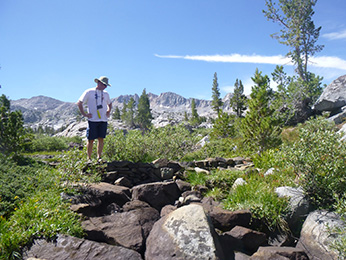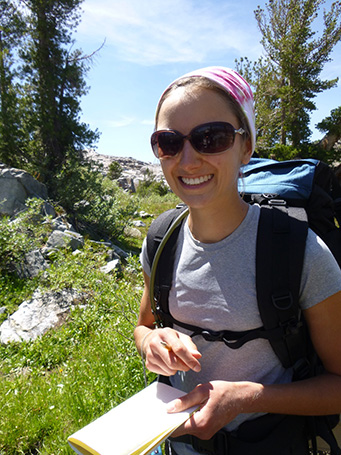(West Walker River, Hoover Wilderness, Humboldt Toiyabe National Forest, Mono County)
Species / Location
Stella Lake is located in the headwaters of the West Walker River in the Hoover Wilderness, Humboldt Toiyabe National Forest, Mono County (Figures 1 and 2).
Prior to stocking of trout as early as the 1800’s, the high elevation lakes and streams of the Sierra Nevada mountains were fishless. Historical inhabitants of these water bodies, the Sierra Nevada yellow-legged frog (Rana sierrae), require large, deep lakes and ponds as well as meadow streams, similar to habitat needs for the introduced trout which are predators of frogs (Figure 3). This species of frog also requires multiple summers to metamorphose from a tadpole to a frog, making it more susceptible to predation by trout with which it did not co-evolve. To restore frog populations, trout are removed from lakes and streams. Frogs from nearby bodies of water then recolonize into those fishless waters. Locations where CDFW manages resources to improve recreational fisheries and/or restore ecological benefit is guided in the eastern Sierra Nevada mountains by CDFW’s Aquatic Biodiversity Management Plans. The plan for the West Walker Basin listed the lake adjacent to Stella Lake (Ruth Lake) as important habitat for frog restoration, but categorized this as “infeasible” due to the long distance of stream that would need to be treated and the difficulty in removing the trout by mechanical means alone.

Figure 1. View of Stella Lake, located in the headwaters of the West Walker River in the Hoover Wilderness, Humboldt Toiyabe National Forest, Mono County. Photo by CDFW Dawne Emery.

Figure 3. Photo of Sierra Nevada yellow-legged frog (Rana sierrae). Photo by CDFW Dawne Emery.
Need for Drought Stressor Monitoring
After several years of drought, conditions have changed, and streams feeding into and flowing out of both Stella and Ruth lakes have dried enough to allow biologists to successfully remove fish by mechanical means. Drought has on its own also reduced trout populations by drying (and thus eliminating) spawning habitat from the inlet and outlet streams of the lake. As the numbers of fish declined, the average size of fish increased, likely due to reduced competition for food as well as by redirecting energy to growth (rather than reproduction) with limited spawning habitat in the streams. The larger the fish, the greater the amount of food is needed for the fish to persist, and larger food items—such as tadpoles and young fish—are targeted. The overall reduction in number and increase in size of trout has made fish removal more feasible. Prior to the drought, the rainbow trout in Stella Lake ranged from five and seven inches long and brook trout ranged between six and eight inches.
Removal of trout from lakes through use of monofilament nets (gillnets) for frog habitat restoration has occurred since 1992 when researcher Roland Knapp conducted an experimental removal and concluded this to be an effective method for some bodies of water under the right conditions. Mechanical removal of fish from mountainous streams can be difficult, labor-intensive, and can be infeasible if the stream is too long and trout can avoid capture. Another limitation is that field work is limited to the summer and early fall when water bodies are free of ice and access by biologists isn’t precluded by snow. During the spring, high flows caused by snow melt often block access to back country waters.
Restoration and Stressor Monitoring Efforts
CDFW and Humboldt Toiyabe National Forest (National Forest) staff, along with volunteers, conducted two trips to Stella Lake, a longer trip in July and a shorter trip in September 2014. The crew deployed up to 50 gillnets in the two periods by draping them vertically from empty plastic bottles that act as floats. Setting and capturing of fish from nets was done by biologists and volunteers from float tubes (Figure 4). The theory behind use of gillnets is that fish swim into the net, and due to their elliptical shape and ensnaring of their gills, cannot back out to escape. In reality, they often just brush up against the net and get tangled. It is possible to catch non-target animals such as birds or small mammals if the nets are left unattended or if the nets are not totally submerged. We find that catching of non-target animals, called “incidental catch”, is rare, and we made sure that field crews were present during the entire deployment of gillnets at Stella Lake.
In addition to removing fish, CDFW has built rock percolation dams that act as fish migration barriers, blocking fish from re-colonizing treated bodies of water, while still allowing stream flow between lakes (Figure 5). Low flows due to drought in combination to the restoration actions taken by CDFW have severely impacted trout populations in this area, thereby improving conditions for the frog populations.

Figure 4. CDFW Environmental Scientist Dawne Emery inspects gillnet for trout at Stella Lake. Photo by CDFW volunteer.

Figure 5. CDFW volunteer inspects the percolation dam which was installed to block invasive trout from accessing restored Sierra Nevada yellow-legged frog habitat. Photo by CDFW Dawne Emery.
Findings
So far, our restoration efforts are already paying off for the frog population. After implementing restoration actions this summer, no trout currently persist in the inlet or outlet streams of Stella Lake and we saw frogs already moving into the first lobe of Stella Lake.
Of the fish we capture, we record the total abundance, species, and approximate sizes (Figure 6). Gillnet locations are documented with Global Positioning System (GPS) units so when their catch is recorded, we can determine “hotspots” and reposition nets to those locations to maximize catch. We utilize gillnets of varying mesh sizes so that we can capture fish of a wide size range. To distinguish the different nets, the crew uses a naming system: Tangled; Coffee; Rue; Cosmo; Ugly Prom Dress; Midnight Special; etc.
For Sierra Nevada yellow-legged frog surveys, we count the frogs present and note their age class: whether they are an adult, sub adult, or tadpole, and if a tadpole, we note the different size classes. Habitat, including breeding sites, is documented in these surveys. In our surveys in this area, we observed that frogs currently persist in drying meadow habitat upstream of Ruth Lake (upstream of Stella Lake).

(Figure 6. CDFW volunteer records data. Data collection and monitoring is an important component of implementing restoration.)
Future Efforts
CDFW plans to continue restoration actions at Stella Lake in 2015. If the drought continues through 2015, CDFW anticipates needing only three or four more trips. If the drought ends, the increase in the size of the lake may require additional removal efforts.